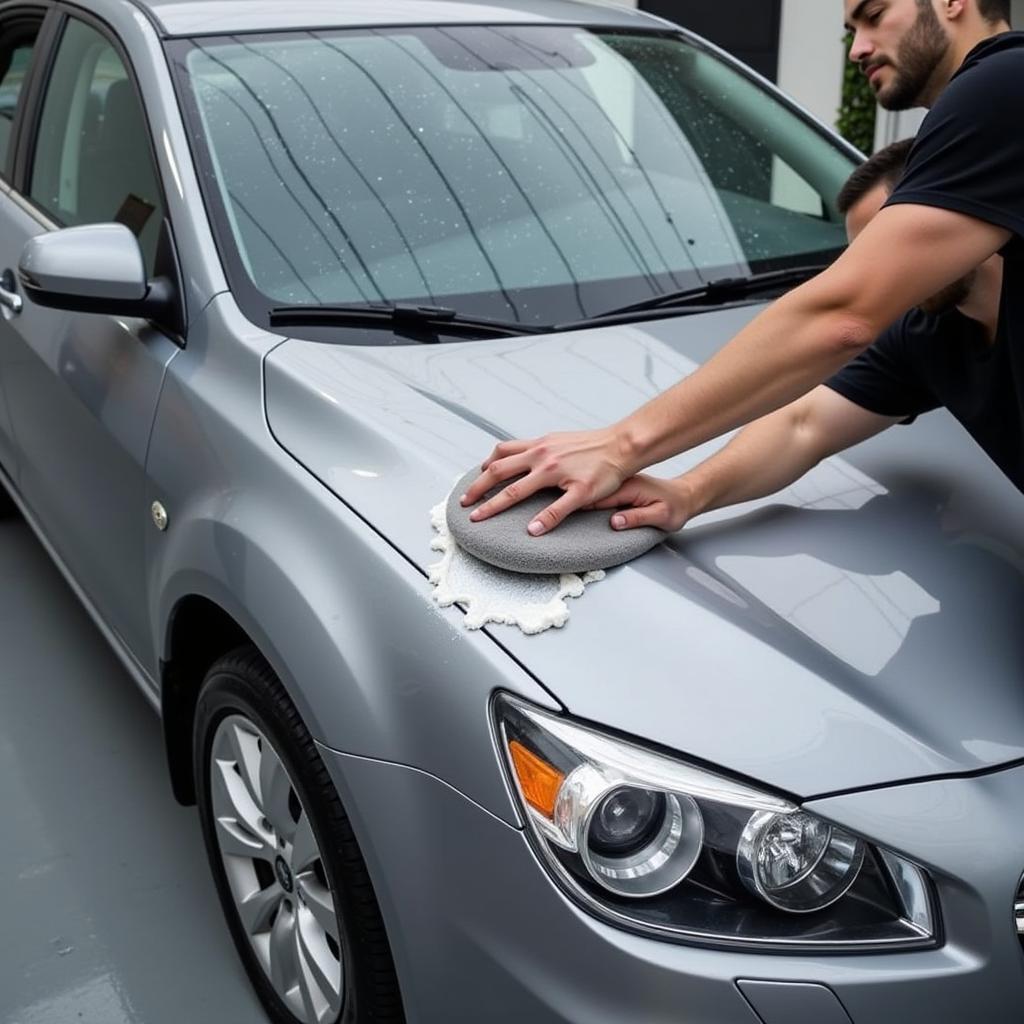Car Detailing Oxidizing Metal is a critical process for maintaining the appearance and longevity of your vehicle. Oxidation, the chemical reaction between metal and oxygen, can lead to unsightly rust and corrosion, diminishing your car’s value and potentially compromising its structural integrity. Understanding the causes, prevention, and treatment of oxidizing metal is crucial for every car owner.
Understanding Car Detailing and Oxidizing Metal
Oxidation is a natural process that affects all metals, including those on your car. Environmental factors like moisture, salt, and air pollutants accelerate this process. When detailing your car, addressing oxidizing metal isn’t just about aesthetics; it’s about protecting your investment. Different metals oxidize at varying rates. For instance, iron oxidizes relatively quickly, forming rust, while aluminum develops a protective oxide layer that slows down further corrosion.
Why is Addressing Oxidizing Metal Important During Car Detailing?
Ignoring oxidizing metal during car detailing allows the corrosion to worsen. Rust, in particular, spreads like a disease, eating away at the metal and weakening the affected area. Early intervention through proper detailing techniques can prevent this damage and preserve your car’s finish.
How to Identify Oxidizing Metal
Recognizing the signs of oxidizing metal is the first step in tackling the problem. Look for:
- Discoloration: Rust appears as reddish-brown patches, while other metals might show a dull, whitish film.
- Rough Texture: Oxidized metal often feels rough or bumpy to the touch.
- Pitting: In advanced stages, you might notice small pits or holes in the metal surface.
Preventing Oxidizing Metal on Your Car
Prevention is always better than cure. Here are some preventative measures you can take:
- Regular Washing: Frequent washing removes contaminants that contribute to oxidation.
- Waxing and Sealing: Applying wax or sealant creates a protective barrier against the elements.
- Garaging: Storing your car in a garage shields it from harsh weather conditions.
- Protective Coatings: Consider professional ceramic coatings for long-lasting protection.
 Preventing Metal Oxidation During Car Detailing
Preventing Metal Oxidation During Car Detailing
Treating Oxidizing Metal During Car Detailing
If your car already shows signs of oxidation, don’t despair. Several detailing techniques can effectively address the issue:
- Cleaning: Thoroughly clean the affected area with a specialized car wash soap.
- Clay Bar Treatment: A clay bar can remove embedded contaminants that contribute to oxidation.
- Polishing: Polishing removes the oxidized layer, restoring the metal’s shine.
- Compounding: For more severe oxidation, compounding provides a more aggressive approach to removing the damaged layer.
Choosing the Right Products for Treating Oxidizing Metal
Selecting the right products is essential for effective treatment. Using abrasive products on delicate surfaces can cause further damage. Consult a professional detailer for advice on the best products for your car’s specific needs.
“Choosing the right product is crucial,” says renowned detailing expert, Michael Davies, “Using the wrong compound can actually scratch your paintwork and make the problem worse.”
Advanced Techniques for Car Detailing Oxidizing Metal
For severe cases of oxidation, more advanced techniques might be necessary. These include:
- Sanding: Wet sanding can remove deep rust and pitting, but it requires expertise to avoid damaging the surrounding paint.
- Metal Restoration Products: Specialized products are available for restoring heavily oxidized metal surfaces.
“For truly stubborn oxidation, sometimes you need to bring out the big guns,” explains detailing veteran, Sarah Chen, “Techniques like wet sanding can be incredibly effective, but it’s vital to know what you’re doing.”
Conclusion
Car detailing oxidizing metal is a crucial aspect of maintaining your vehicle’s appearance and structural integrity. By understanding the causes, prevention methods, and treatment options, you can effectively combat oxidation and keep your car looking its best. Remember, regular maintenance and proactive detailing are key to preventing costly repairs down the road.
FAQ
- What causes metal to oxidize? Exposure to oxygen and moisture, accelerated by environmental factors.
- How often should I wax my car to prevent oxidation? Every three to six months, depending on environmental conditions.
- Can I treat oxidizing metal myself? Yes, for minor oxidation. For severe cases, consult a professional.
- What is the best way to remove rust from my car? Depending on the severity, it can range from polishing to sanding and metal restoration.
- How can I protect my chrome trim from oxidation? Regular cleaning and application of a chrome polish.
- Is it possible to prevent oxidation completely? While you can’t stop it entirely, you can significantly slow it down with proper care.
- How much does professional rust removal cost? It varies depending on the severity and the area affected.
Need help with car detailing oxidizing metal? Contact us via WhatsApp: +1(641)206-8880, or Email: [email protected]. Our 24/7 customer support team is ready to assist you.

Leave a Reply